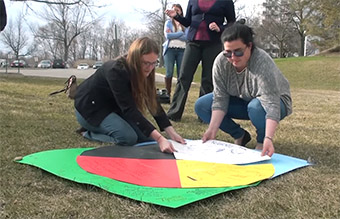Lindsay Morcom thinks of the various aspects of her research as being like three strands of sweet grass braided together. “They’re three different streams, but closely connected,” she says, explaining that each explores an aspect of Indigenized education and reconciliation. “We can’t have one without the other.”
Since joining the Faculty of Education as an assistant professor in 2013, Dr. Morcom, who is also the coordinator of the Indigenous Teacher Education program (ITEP) at Queen’s and a Canada Research Chair in Language Revitalization and Decolonizing Education, has focused her attention on the revitalization of Indigenous language and culture.
![Hand with burning sweetgrass [hand with burning sweetgrass]](https://www.queensu.ca/research/sites/default/files/assets/featured_story/chiefladybird-sweetgrass-smudge-1800.jpg)
The first strand:
Language revitalization through immersion education
As a linguist and educator who also identifies as Anishinaabe, Dr. Morcom is interested in the role native language plays in building self-esteem and improving graduation outcomes for Indigenous children.
She is currently working in partnership with an Anishinabek immersion school on Manitoulin Island, Lakeview School at M’Chigeeng First Nation, on a program called the Ngwaaganak Immersion Program helping to track the academic, linguistic, and personal development of children being educated in their Indigenous language.
“Research shows that children who speak their heritage language also have higher graduation rates,” she says, explaining that the immersion program is based in a community where the Indigenous language is considered to be endangered. That’s why the United Chiefs and Council of Mnidoo Mnising produced a declaration, as part of a larger self-governance and self-determination policy, that by 2030 all of their community services would be available in Anishinabemowin (the language of the Anishinaabe people), which also requires that children have the opportunity to learn it fluently.
Dr. Morcom, who is taking a community-based, collaborative approach to her research, is not only tracking cognitive development and school skills among students in the early immersion program, but also looking at their self-esteem and pride at being Anishinaabe people. “We want to make sure that these children are learning the language – that’s of the utmost importance – but also that they will be able to engage academically on any path that they want,” she says.
![Wampum [wampum illustration]](https://www.queensu.ca/research/sites/default/files/assets/featured_story/chiefladybird-wampum-1800.jpg)
The second strand:
Revitalizing Indigenous languages in Kingston
Dr. Morcom is also committed to the development of Indigenous language in her own community. She is an active participant in the Kingston Indigenous Language Nest (KILN). KILN offers many programs, including bi-weekly language learning opportunities for families, free, community-based language classes for teens and adults, and language resources that are produced in partnership with other organizations, like Loving Spoonful and Community Story Strategies, as well as in-school language opportunities in partnership with school boards. The group focuses on Anishinaabemowin (the language of the Anishinaabe people) and Mohawk, the languages of this territory. “We have always shared this territory, so we go back and forth between the two languages,” says Dr. Morcom, explaining that meetings also honour the Dish with One Spoon treaty by building an inclusive community from different Indigenous Nations.
As part of her research, Dr. Morcom helps to plan the language learning opportunities, which attract everyone from Elders in the community to children and are built using a non-hierarchical model, typical in Indigenous communities. Dr. Morcom says KILN events have become more than just a tool for learning languages: they are a place for Kingstonians to develop pride in their heritage and each other. “The Kingston Indigenous Language Nest is inclusive of people at all language levels and from all walks of life,” she says. “That’s the real benefit of it.”
![Two people conversing [two people conversing]](https://www.queensu.ca/research/sites/default/files/assets/featured_story/cheifladybird-faces-1800.jpg)
The third strand:
Championing Indigenized and reconciliatory education
For Dr. Morcom, reconciliatory education means finding ways to create “meaningful ally-ships” between Indigenous and non-Indigenous populations, especially within the academic community. “If we want things to improve in Canada, we have to question colonization and we have to look at how we can collaborate with settler communities in order to work towards reconciliation,” she explains. “That is the issue. Language loss is still happening. Schools are still underfunded. Treaties are not honoured. Colonization is still happening.”
Dr. Morcom is part of a collaborative research group made up of Indigenous and non-Indigenous female researchers at universities across Canada who have looked at decolonizing and reconciliatory behaviour at various academic institutions, among other topics. As well as leading a well-received session on issues of reconciliation at the 2017 Congress of the Humanities and Social Sciences, the group co-edited an issue of the Canadian Journal of Native Education and will continue to co-author papers. They are currently collaborating on additional publications and conferences.
“The research I do is so collaborative, but that’s how it should be in Native education,” says Dr. Morcom, “because if you are doing it by yourself in a corner, then you are not reflecting community.”
![Lindsay Morcom [Photo of Lindsay Morcom]](https://www.queensu.ca/research/sites/default/files/assets/featured_story/Morcom-2560.jpg)

Lindsay Morcom
Building on current on-reserve and urban research on language revitalization: this research will use a multigenerational approach and work in partnership with Indigenous communities to identify goals and best practices for education and language planning.

![[illustration- ring of sweetgrass]](https://www.queensu.ca/research/sites/default/files/assets/featured_story/cheifladybird-sweetgrass-ring-250_0.png)
![[feather illustration]](/research/sites/default/files/assets/featured_story/feather.png)

![[turtle island emoji]](https://www.queensu.ca/research/sites/default/files/assets/featured_story/kisspng-turtle-island-emoji.png)